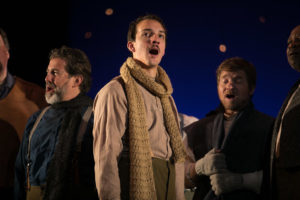
San Diego Opera 2018-19 Review: All is Calm
By Maria NockinOn December 7, 2018, the 77th anniversary of the Japanese attack on Pearl Harbor, HI, San Diego Opera presented writer and director Peter Rothstein’s musical play on a unique wartime story: “All is Calm: The Christmas Truce of 1914.”
The work seen at the Balboa Theatre also served as a remembrance of the 100th anniversary of the armistice that concluded the 20th century’s first global war. Originally, San Diego Opera had planned on presenting Humperdinck’s “Hansel and Gretel,” but the scenery they wanted to use did not fit the Balboa’s stage.
In 2007, writer and director Peter Rothstein turned this true tale into a radio drama with the help of Erich Lichte who arranged the music. Later Timothy C. Takach made further arrangements of the score. The stage show was developed and produced by Cantus and Theater Latté Da in Minneapolis. The San Diego Opera show is a co-production with Bodhi Tree Concerts and Sacra/Profana. Bodhi Tree has presented the work during two pervious holiday seasons, but the opera company is offering it to a larger and more diverse audience.
Christmas Miracle
When British troops went off to war in 1914, they expected to be victorious in short order and to return home in time for Christmas. “All is Calm” shows what actually happened instead. The war continued for four years and the one-day truce was the only cessation the foot soldiers in the trenches of Belgium would see. On Christmas Eve, German and British troops lit candles and sang carols to each other across the “no man’s land.” At dawn some German soldiers came up out of the trenches and approached the British yelling “Merry Christmas.” Although at first the English speakers feared trickery, when they saw that the Germans were unarmed, they joined them in celebration of the season.
Scenic designer Tim Wallace outlined the rural setting with with piles of rocks. Costume Designer Denitza Bliznakova gave the German soldiers heavy brown overcoats. When they removed these coats they turned into British troops from various parts of the country. Some wore work pants with army caps and others regimental kilts complete with bonnet and sporran.
Although Director Alan E. Hicks worked with a small stage that had very little depth to it, he created the impression of one field among many that had long since been abandoned by farmers. There were no women or children. Only young men were there to fight and die for their respective countries. Hicks made us realize that despite the patriotic songs and the revelry of recruitment, at some point the men wondered why. It is also interesting to note that in early December, 1914, Pope Benedict XV asked both sides for a Christmas truce and was refused.
Carols & Poetry
Along with the carols and songs of the period, members of the cast read poems and letters written by World War I soldiers, some famous and some just ordinary “grunts.” Ensemble members often spoke in the dialects of the British Isles, thanks to English-born Dialect Coach Vanessa Dinning. She helped each British soldier create a specific character from a particular place, until he put on his coat and became a German soldier. Only a little German was spoken, however, so there was no question of high or low German speech. Someone on the other side of the pond might want to do this piece from a German point of view.
Hicks’s British and German soldiers treated each other as equals for a few hours. They did what young men often do when no women are present. They smoked, drank all the alcohol in sight, and ate everything they could find. Then they played soccer before realizing that it would be a good deed for each side to bury the dead comrades lying between their trenches. Hicks’s soldiers were as real as today despite their early twentieth century costume and speech
The lighting design of Anne E. McMills gave the impression of violent warfare with sudden lights punctuated by darks, followed by starlight when the fighting ceased. There were no strobes or lightening strikes, just the lights of war and the calm ambience of its cessation during the truce. It is a perfect choice for a Christmas show
A Cappella
All the singing by the 16-voice ensemble was a cappella. Conductor Juan Carlos Acosta led the group from below the stage and I never heard a pitch pipe keeping singers on key. They were able to stay on their correct notes with only the assistance of an occasional hummed tone and their musicianship was nothing short of amazing.
In putting together this show, Director Peter Rothstein used 17 traditional carols from various warring countries intermingled with a few patriotic tunes and songs from the period such as “Pack up your Troubles in Your Old Kit Bag.” ”Silent Night/Stille Nacht,” of course, had a central spot in the score.
Solo tenor Timothy Simpson sang a lyrical rendition of ”Minuit Chrétiens/O Holy Night” in both French and English. His bronze-tinged tones had a remarkable pristine clarity that seemed to epitomize the clear cold of Christmas Eve in Northern Europe.
Sadly, after the rendition of ”Auld Lang Syne,” officers from both armies came with threats of bodily harm if the soldiers did not resume their duties. The Truce ended with death dealing finality as a German soldier was shot for being above his trench. The truce was little reported at the time because it was thought to encourage anti-war activity in wartime. I wonder if we have learned anything since 1914.


